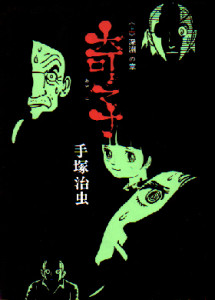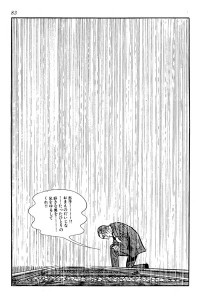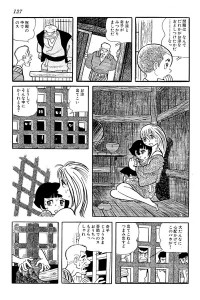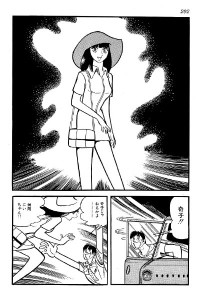Ayako (Manga)
Also known as 奇子 (Ayako)
| English Title: | Ayako |
| In English? | Yes |
| Japanese Title: | 奇子 Ayako |
| Type: | Ongoing Serial |
| Original run: | 1972-01 to 1973-06 |
| Published in: | Big Comic ビッグコミック |
| Published by: | Shogakukan |
| Volumes: | 3 MT-197 | MT-198 | MT-199 |
Ayako (1972-73) is another of Tezuka’s dark social commentaries on the effects of war on society. Created during Tezuka’s “dark period”, it was originally serialized in Big Comic from January 1972 to June 1973. As such, it falls between similar works Ode to Kirihito (1970-71) and Barbara (1973-74).
What it’s about
The story begins just after the end of the Second World War, as Jiro Tenge, second son of the moderately wealthy Tenge family, returns home after being held as a prisoner of war by the Americans. For many years the Tenge family had been large landholders, and the leaders of their local community, with many tenants and dependents. However, when the government imposes mandatory land redistribution after the war, the family is stripped of much of their land – and would have lost more if not for a series of bribes and favours. The situation has placed a tremendous amount of stress on the traditional, somewhat medieval, family dynamics.
Jiro soon learns that, during his absence, his father, Sakuemon Tenge, has promised to hand over his title as head of the family to his eldest son, Ichiro, if he marries Sue and then agrees to let her become his father’s mistress. Rounding out the family is Jiro’s doting mother Iba, his carefree-seeming younger sister, Naoko, who has secretly joined a socialist movement, something that could get her banished or even killed if Ichiro finds out, his youngest brother Shiro, a good-natured and intelligent boy living under Ichiro’s thumb, and his youngest sister, Ayako. Born during Jiro’s absence five-year-old Ayako, despite everyone’s claims that she’s just another sibling, is quite obviously Sakuemon’s child by his son’s wife, Sue.
Unfortunately, Jiro’s return is not a happy one. Despised by his father and the local villagers for allowing himself to have been taken prisoner during the war, Jiro is, in fact, working as a spy for factions within the American occupation government. When Ayako witnesses some of Jiro’s dirty work, Sakuemon and Ichiro browbeat the family into locking Ayako up in a storeroom for the rest of her (assumed to be short) life.
Despite the efforts of Sue and Shiro, Ayako is forced to live for over twenty years in the one-room storeroom. However, when circumstances eventually allow her to leave, Ayako, now an attractive young women, ventures out into the terrifying outside world. Although she finds her way into Jiro’s care, her freedom ultimately brings about the downfall of the Tenge family.
What you should know
Ayako (1972-73) is, along with MW (1976-78) and Message to Adolf (1983-85), one of a number of dramatic social commentaries Tezuka wrote later in his career. Like many of these, Ayako (1972-73) relies very little on Tezuka’s Star System, with the only major character to appear being Inspector Geta, the detective following the Tenge case. It also contains no elements of science-fiction or fantasy, instead focusing on the dark, real-world story of evils – both individual and social generated by the Second World War and its aftermath.
In Ayako (1972-73), Tezuka explores the American occupation of Japan after the conclusion of the war, and the damage done to traditional, particularly wealthy, Japanese families. By focusing on a large landholding family of samurai descent, Tezuka is able to show how the post-war years, with the dramatic land redistribution policies of the American occupation government and rise in social activism, served to crack apart the already weakened traditional Japanese family structure. Although the Americans, or at least certain factions within the occupying forces, trigger the sad series of events through their manipulation of Jiro, Tezuka makes it clear there is enough blame to go around. The Tenge clan is already rotten to the core, and the occupation is merely exposing that weakness – it’s the last stone that causes a rock slide.
Tezuka uses Ayako herself as an allegory for Japan’s social woes. On the one hand, she is an innocent, despite her scandalous origins, and her suffering and degradation parallels that of society. What’s more, there are no heroes to rescue her. None of the other characters are able to stand up to the injustice of her imprisonment, the best they can do is to continue to keep her “safe” in a box and feed her twisted desires. Despite this, Ayako continues to live long past anyone’s predictions – illustrating another of Tezuka’s favourite themes, that life will prevail no matter how cruel or impossible the situation.
Ayako may represent the suffering of women in dark times, the degenerating condition of the Japanese people, or simply the debasement of life in the aftermath of war, but Tezuka also uses her to show that even when all that is good in life has been corrupted, it is still worth fighting for, even if it has fight for itself.
Where you can get it
In 2010, Ayako (1972-73) was translated into English and released by Vertical Inc. in a lovely, 700-page single volume hardcover edition. It was re-released in 2013 as a softcover edition.






